HISTORY OF THE HOLY MONASTERY OF TROODITISSA
The Holy Monastery of Panagia Trooditissa is one of the most ancient monasteries on the island of Cyprus. It owes its name to its location, within the delightful embrace of the pine-clad Troodos range.
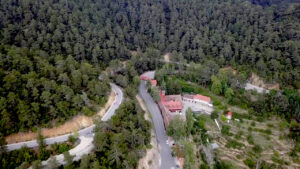
Τhe pine-clad Troodos range.
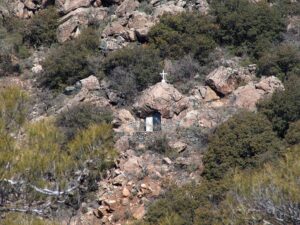
The Holy Cavern.
Tradition and history alike lend support to the great age of the Monastery. During the years of the Iconoclastic Controversy, many monks fled to places such as Cyprus, where the will of the iconoclast emperor did not apply. More specifically, tradition holds that the Monk who had brought with him an icon of Panagia, the icon later named “Trooditissa”, sought refuge to the Monastery of St Nicholas “of the Cats,” near the village of Akrotiri in Limassol.
After spending approximately twenty five years in that famed Monastery, the Monk developed a deep yearning for the anachoretic way of life and for hesychasm (divine quiet). Panagia helped him fulfill this pious yearning as she appeared in his sleep and instructed him to carry the icon to a place where he would see a column of fire.
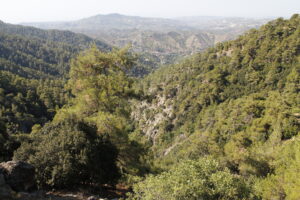
The mountain of Afames (a view from the holy Cavern).
The ascetic Monk took his well-wrapped sacred treasure, the icon of Panagia, and set out toward a mysterious glow. The glow guided him to a cave, known to this day as “The Cavern of Trooditissa,” near the northeast side of the Monastery.
Inside this peaceful, otherworldly cave, the Monk would spend the remaining years of his life, devoted to fasting, vigil and prayer.
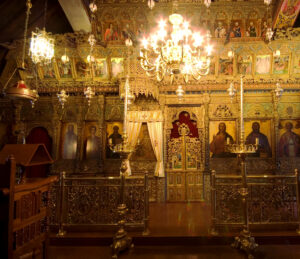
Interior view of the katholikon with the carved-wooden iconostasis.
He died before being graced to build a church, as he desired, wherein the icon would be kept in complete safety.
The years passed and the icon of Panagia remained unseen inside the cavern. Around the year 990, a pious shepherd from the village of Afames saw a light between rocks, somewhere up in the Troodos mountains. [3] The shepherd was certain that the light he saw every night was not an ordinary occurrence. He spoke of the mysterious glow to others and a group of men accompanied by a priest set out to look closer. The light guided them to the entrance of a cavern. Once inside the cavern, to their great surprise, they realised that nobody lived there, nor were there any visible traces of human activity; nevertheless, a vigil lamp burned, placed before a beautiful icon of the Virgin Mary.
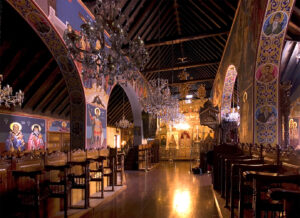
Interior view of the katholikon.
The discovery of the cavern with the venerable icon of Panagia and the wondrous light caused ripples of emotion among devout Christians. There followed a decision to build a small church near the Sacred Cavern.
To this purpose, builders from the adjacent villages were hired and foundation works began. It was a very difficult task because of the steep slope of the land and the hardness of rocks in the area, which made them very difficult and expensive to use.
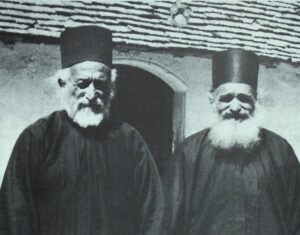
Overseer Damascene (1939-1942) and to his left his brother Paisios.
Water required for clay was transferred in jugs from the small river that ran near the left side of the cavern. Still, an invisible power was said to impede the transfer of water, as the jugs kept sliding from the shoulders of the men, falling to the ground and breaking into pieces. In spite of their efforts, there was no progress in the construction of the church. What was the meaning of all this?
One morning, without explanation, a jug of clear water was found to the west of the cavern, on the present-day site of the Monastery. This was a token of God’s providence, meant to point out the location of a hidden spring of water which would also serve as a suitable site for building a church. Indeed, the men dug where the jug was found and discovered the water spring; near the spring there was also a flat expanse of land. Without further ado, they set out to lay the foundations and their work progressed unhindered.
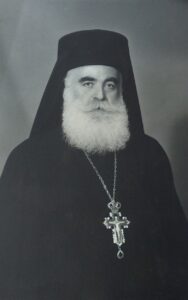
Hegoumen Pangratios (1942-1968).
Once the building of the small church was completed, the icon of Panagia, that had been found in the cavern, was placed inside it. Subsequently, seeing that the location of the church attracted ascetics, as it was away from residential areas and graced with absolute quiet –a basic requirement for monasticism – monastic cells were gradually built around the church and the complex gradually evolved into a Monastery.
Unfortunately, information about the history of the Monastery of Trooditissa during Latin Dominion (1191-1571) is very scarce.
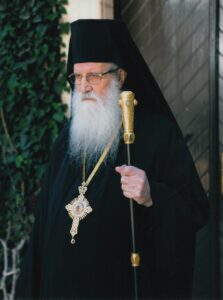
Hegoumen Athanasios (since 1968).
After the conquest of Cyprus by the Turks in 1571, the Monastery suffered several misfortunes; these were culminated in the year 1585, when it was set to fire by the Turkish conquerors. The Monastery was ruined, but the icon of Panagia was found miraculously intact under an apple tree in the adjacent garden; other relics and icons were also found intact. These items are kept in the Katholikon and the Monastery’s Sacristy to this day. The few Monks had fled to the forest and saved themselves. When the sociopolitical conditions ceased to be adverse, they went on to rebuilt the Monastery and the church, headed by Hegumen Parthenios.
Unfortunately, the church once again burned down, because of a forgotten candle, in the late 1842. Without delay, the determined Hegumen Meletios took pains to build the new, three-aisled church which stands to this day.
The most important spiritual landmark in the modern history of the Monastery, during British rule (1878-1960), came in 1939, after the death of Hegumen Iacovos, when Metropolitan Leontios of Pafos changed the form of the Monastery from an idiorrhythmic system to a coenobitic one. To this purpose, he invited Monks from the Monastery of Stavrovouni, appointing the Most Reverend Monk Damaskinos as Head. Three years later, upon the death of Monk Damaskinos, Metropolitan Leontios of Pafos ordained Archimandrite Pangratios as Hegumen. In April 1968 Hegumen Pangratios rested in peace and was succeeded by Hegumen Athanasios, who holds this position to this day.
The Holy Monastery of Trooditissa celebrates on 15 August, on the feast-day of the Dormition of Theotokos.
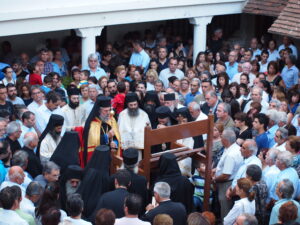
Pilgrims to the Monastery on its feast-day (Vesper 14.8.2014).